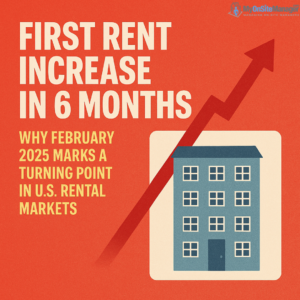After months of stagnation, U.S. rent prices are on the move again. According to a new Redfin report, the national median asking rent rose 0.4% year-over-year in February 2025, bringing the median to $1,607. While this may seem like a modest increase, it’s a meaningful shift—marking the first annual uptick since June 2024, and the largest since May 2024.
What’s Behind the Rise?
Several key dynamics are contributing to the current shift in the rental landscape:
1. Slowing Supply Growth
Over the past couple of years, a boom in apartment construction helped flood the market with inventory, especially in fast-growing regions like the Sun Belt. This surge in supply played a major role in stabilizing—or even deflating—rents in 2023 and early 2024.
But that growth is now easing. High interest rates, rising construction costs, and tighter lending conditions are slowing new developments. As a result, fewer new units will hit the market in the coming months, tightening availability and giving landlords more pricing power.
2. A Market Seeking Balance
The rent market has been volatile since 2020. First, rents surged during the pandemic housing frenzy, with some cities seeing increases of over 20%. Then came the cooldown in 2023, driven by more supply and economic uncertainty.
Now, 2025 appears to be a rebalancing year—with modest rent increases reflecting a more stable equilibrium between supply and demand.
Regional Rental Trends: A Tale of Two Markets
Not all cities are experiencing the same trend. Some metro areas are seeing rents spike, while others continue to fall. Here’s a breakdown of the top gainers and decliners:
Biggest Rent Increases (YoY, February 2025):
-
Cincinnati, OH – +15.3%
-
Providence, RI – +12.4%
-
Baltimore, MD – +9.6%
-
Washington, D.C. – +9.2%
-
Cleveland, OH – +8.5%
These markets are generally lower-cost cities with strong job growth and limited new supply. Their affordability, relative to coastal hubs, is attracting new renters and driving up demand.
Biggest Rent Declines:
-
Austin, TX – –9.4% (down 22% from its 2023 peak)
-
Salt Lake City, UT – –7.8%
-
Jacksonville, FL – –6.7%
-
Minneapolis, MN – –5.9%
-
San Diego, CA – –5.6%
In contrast, Sun Belt cities—especially those that overbuilt—are still dealing with elevated vacancy rates. Many landlords in these markets are offering concessions to fill units, which continues to pull asking rents downward.
How Unit Size Affects Rent Trends
Unit size also plays a key role in rental trends:
-
Studios & 1-bedrooms: Up 0.4% YoY, now at $1,467
-
2-bedrooms: Up 0.6% YoY, now at $1,689
-
3+ bedrooms: Down 0.5% YoY, now at $1,990
Smaller units are gaining popularity, likely due to affordability concerns and shifts in household formation. Meanwhile, larger family-style rentals are still under pressure as some tenants downsize or double up.
Renter Sentiment and the Bigger Picture
Despite the increase, rents are still below their peak of $2,054 reached in August 2022. That said, the recent bump could mark the end of the renter’s reprieve.
Redfin economist Sheharyar Bokhari put it bluntly:
“The era of big rent declines is over.”
As the economy continues to grow and interest rates remain high, homeownership remains out of reach for many. That leaves the rental market as the primary housing option—boosting demand, especially in urban areas with limited vacancy.
What to Expect for the Rest of 2025
Looking ahead, renters should prepare for:
- Modest rent increases in most major metros
- More competition for smaller, centrally located units
- Fewer move-in specials or incentives, especially in undersupplied areas
- Renewed affordability challenges as wages lag behind rent hikes
Unless there’s a resurgence in apartment construction or a sharp economic downturn, pressure on rents is likely to grow.
Final Thoughts
February’s numbers may seem minor, but they signal a turning point in the U.S. rental market. As supply slows and demand stays strong, the next few months could shape the affordability landscape for millions of renters nationwide.
Now is the time for renters to:
-
Lock in lease renewals before further increases
-
Explore concessions in oversupplied cities
-
Monitor local market trends to stay ahead
Source: Redfin via Forest Economic Advisors (March 2025) U.S. Median Asking Rent Increases 0.4% Year-Over-Year in February

